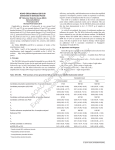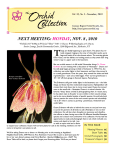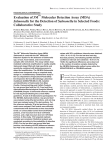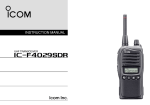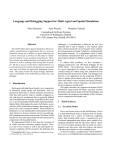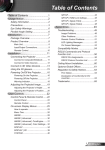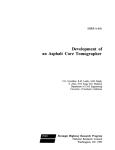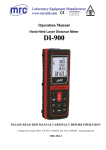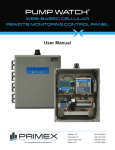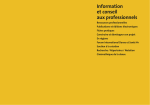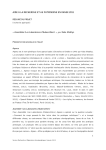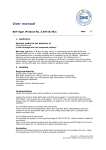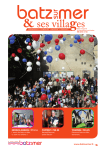Download 3M Molecular Detection Assay Listeria monocytogenes AOAC Study
Transcript
980 Bird et al.: Journal of AOAC International Vol. 98, No. 4, 2015 MICROBIOLOGICAL METHODS Evaluation of 3M™ Molecular Detection Assay (MDA) Listeria monocytogenes for the Detection of Listeria monocytogenes in Selected Foods and Environmental Surfaces: Collaborative Study, First Action 2014.07 Patrick Bird, Jonathan Flannery, Erin Crowley, James Agin, and David Goins Q Laboratories, Inc., 1400 Harrison Ave, Cincinnati, OH 45214 Lisa Monteroso1 and DeAnn Benesh 3M Food Safety Department, 3M Center – Bldg 260-6B-01, St. Paul, MN 55144 Collaborators: B. Bastin, J. Blumfield, B. Brahmanda, A. Brandt, R. Brooks, R. Brooks, L. Cerda, C. Chavarria, Y. Chen, N. Cuthbert, R. Dermer, P. Fatemi, A. Hankins, L. Hardrath, B. Kupski, A. Laasri, C. Lopez, B. Mailloux, A. Morris, J. Picket, K. Powers, J. Schoeni, N. Shipley, S. Spencer, A. Sweet, A. Thielen, L. Thompson, J. Williams, D. Wood The 3M™ Molecular Detection Assay (MDA) Listeria monocytogenes combines isothermal amplification and bioluminescence to detect Listeria monocytogenes with high specificity and efficiency in select foods and environmental samples. The 3M MDA Listeria monocytogenes method was evaluated using an unpaired study design in a multilaboratory collaborative study to the U.S. Department of Agriculture, Food Safety and Inspection Service Microbiology Laboratory Guidebook 8.09 (2011) Isolation and Identification of Listeria monocytogenes from Red Meat, Poultry, and Egg Products and Environmental Samples for deli turkey, and the AOAC Official Method of AnalysisSM 993.12 Listeria monocytogenes in Milk and Dairy Products for full-fat (4% milk fat) cottage cheese following the current AOAC guidelines. A total of 16 laboratories located in the continental United States and Canada participated in this collaborative study. For deli turkey, 125 g test portions were evaluated using heat-stressed cells by each method. For full-fat cottage cheese, 25 g test portions were evaluated using nonheatstressed cells. Each matrix had three inoculation levels: an uninoculated control level (0 CFU/test portion), and two levels artificially contaminated with L. monocytogenes, a low inoculum level (0.2–2 CFU/test portion) and a high inoculum level (2–5 CFU/test portion). In total, 1584 unpaired Received February 2, 2015. The method was approved by the Expert Review Panel for Microbiology for Food and Environmental Surfaces. The Expert Review Panel for Microbiology for Food and Environmental Surfaces invites method users to provide feedback on the First Action methods. Feedback from method users will help verify that the methods are fit for purpose and are critical to gaining global recognition and acceptance of the methods. Comments can be sent directly to the corresponding author or [email protected]. Supplemental Tables and Figures are available on the J. AOAC Int. website, http://aoac.publisher.ingentaconnect.com/content/aoac/jaoac 1 Corresponding author’s e-mail: [email protected] DOI: 10.5740/jaoacint.15-031 replicate samples were analyzed. Statistical analysis was conducted according to the probability of detection (POD) model. Results obtained for the low inoculum level full-fat cottage cheese test portions produced a difference in cross-laboratory POD (dLPOD) value of –0.08 with a 95% confidence interval (CI) of (–0.20, 0.05). For the low-level deli turkey test portions, a dLPOD value of –0.02 with a 95% CI of (–0.14, 0.11) was obtained. L isteria monocytogenes, a Gram-positive rod shaped facultative bacterium, infects roughly 1600 persons annually (1, 2). On average, infections caused by L. monocytogenes result in 255 deaths in the United States annually, producing one of the highest mortality rates for a foodborne pathogen (2). With its ability to survive and grow in various harsh environments, including propagation at temperatures lower than 1°C, L. monocytogenes continues to be a nuisance to the food industry (2). The 3M™ Molecular Detection Assay (MDA) Listeria monocytogenes method allows for the rapid and specific detection of L. monocytogenes in food and environmental samples after 24 h of enrichment using prewarmed (37 ± 1°C) Demi-Fraser (DF) broth base [without ferric ammonium citrate (FAC)]. After enrichment, samples are evaluated using the 3M MDA Listeria monocytogenes on the 3M Molecular Detection System. Presumptive positive results are reported in real-time, while negative results are displayed after completion of the assay (75 min). Prior to the collaborative study, the 3M MDA Listeria monocytogenes method was certified as an AOAC Performance Tested MethodSM (PTM) following the AOAC guidelines for harmonized PTM studies (3). The goal of the PTM study was to demonstrate that the 3M MDA Listeria monocytogenes method could detect L. monocytogenes in selected foods and environmental surfaces as claimed by the manufacturer. For the 3M MDA Listeria monocytogenes evaluation, there were eight food matrixes and two environmental surfaces analyzed: beef hot dogs (25 g and 125 g), deli turkey (25 g and 125 g), cold smoked salmon (25 g), full-fat cottage cheese (25 g), chocolate Bird et al.: Journal of AOAC International Vol. 98, No. 4, 2015 981 milk (25 g), bagged raw spinach (25 g), romaine lettuce (25 g), cantaloupe (whole melon), sealed concrete (sponge in 100 mL and 225 mL), and stainless steel (sponge in 225 mL) using DF broth base without FAC and, where applicable, a secondary enrichment in Fraser broth (FB) base without FAC. All other PTM parameters (inclusivity, exclusivity, ruggedness, stability, and lot-to-lot variability) tested in the PTM studies satisfied the performance requirements for PTM approval. The method was awarded PTM certification No. 051401 on May 23, 2014. The aim of this collaborative study was to compare the reproducibility of the 3M MDA Listeria monocytogenes method to the U.S. Department of Agriculture (USDA)-Food Safety and Inspection Service (FSIS) Microbiology Laboratory Guidebook (MLG) 8.09 Isolation and Identification of Listeria monocytogenes from Red Meat, Poultry, and Egg Products and Environmental Samples (4) for deli turkey and the AOAC Official Method of Analysis (OMA) 993.12 Listeria monocytogenes in Milk and Dairy Products (5) reference method for full-fat (4% milk fat) cottage cheese. Collaborative Study Study Design In this collaborative study, two matrixes, deli turkey (125 g) and full-fat cottage cheese (25 g), were evaluated. The matrixes were obtained from a local retailer and screened for the absence of L. monocytogenes by the appropriate reference methods prior to analysis. The deli turkey was artificially contaminated with heat stressed cells of L. monocytogenes American Type Culture Collection (ATCC, Manassas, VA) 13932 and the full-fat cottage cheese with nonheat-stressed cells of L. monocytogenes ATCC 19114. There were two inoculation levels for each matrix: a high inoculation level of approximately 2–5 CFU/test portion and a low inoculation level of approximately 0.2–2 CFU/test portion. A set of uninoculated control test portions was also included for each matrix at 0 CFU/test portion for a total of three contamination levels per method. Twelve replicate samples from each of the three contamination levels were analyzed. Two sets of samples (72 total) were sent to each laboratory for analysis by 3M MDA Listeria monocytogenes and either the USDA/FSIS MLG (deli turkey) or AOAC 993.12 (full-fat cottage cheese) reference method due to different sample enrichment procedures between the candidate method and the reference methods. Additionally, collaborators were sent a 30 g test portion and instructed to conduct a total aerobic plate count using 3M™ Petrifilm Aerobic Count Plate (AOAC OMA 990.12; 6) on the day samples were received for the purpose of determining the total aerobic microbial load. A detailed collaborative study packet outlining all necessary information related to the study, including media preparation, test portion preparation, and documentation of results, was sent to each collaborating laboratory prior to the initiation of the study. A conference call was conducted to discuss the collaborative study packet and answer any questions from the participating laboratories. Preparation of Inocula and Test Portions The L. monocytogenes cultures used in this evaluation were propagated in 10 mL of Brain Heart Infusion broth from a Q Laboratories frozen stock culture held at –70°C. Each organism was incubated for 18 ± 0.5 h at 35 ± 1°C. Prior to inoculation, the culture suspension for the deli turkey was heat-stressed at 50 ± 1°C in a water bath for 10 ± 0.5 min to obtain a percent injury of 50–80% as determined by plating onto selective modified Oxford agar (MOX) and nonselective Tryptic Soy Agar with yeast extract (TSA/ye). The degree of injury was estimated as: n select (1 − ) x100 n nonselect where nselect = number of colonies on selective agar and nnonselect = number of colonies on nonselective agar. Appropriate dilutions of each culture were prepared in Butterfields’ Phosphate Diluent based on previously established growth curves for both low and high inoculation levels. Bulk portions of each matrix were inoculated with the diluted liquid inoculum and hand-mixed thoroughly to ensure an even distribution of microorganisms. The inoculated full-fat cottage cheese was divided into separate 30 g portions packaged in sterile Whirl-pak® bags and shipped to the collaborators. For the analysis of the deli turkey, 25 g of inoculated test product was mixed with 100 g of uninoculated test product to prepare 125 g test portions which were packaged in sterile Whirl-pak bags. To determine the level of L. monocytogenes in the matrixes, a five-tube most probable number (MPN) was conducted by the coordinating laboratory on the day of initiation of analysis using the USDA/FSIS MLG 8.09 reference method for deli turkey or the AOAC 993.12 for the full-fat cottage cheese. For deli turkey, the MPN of the high and low inoculated levels was determined by analyzing 5 × 250 g test portions, the reference method test portions from the collaborating laboratories, and 5 × 60 g test portions by the USDA/FSIS MLG 8.09 reference method. For the full-fat cottage cheese, the MPN of the high and low inoculated levels was determined by analyzing 5 × 50 g test portions, the reference method test portions from the collaborating laboratories, and 5 × 10 g test portions by the AOAC 993.12 reference method. Each test portion was enriched at a 1:10 dilution and evaluated following the appropriate reference method. The MPN and 95% confidence intervals were calculated using the LCF MPN Calculator, Version 1.6, provided by AOAC Research Institute (7). Confirmation of the samples was conducted according to the USDA/FSIS MLG 8.09 or the AOAC 993.12 reference method, depending on the matrix. Test Portion Distribution All samples were labeled with a randomized, blind-coded three-digit number affixed to the sample container. Test portions were shipped on a Thursday via overnight delivery according to the Category B Dangerous Goods shipment regulations set forth by the International Air Transportation Association. Upon receipt, samples were held by the collaborating laboratory at refrigeration temperature (3–5°C) until the following Monday when analysis was initiated a total of 96 h post-inoculation. All samples were packed with cold packs to target a temperature of <7°C during shipment. In addition to each of the test portions and the total plate count sample, collaborators also received a test portion for each matrix labeled as “temperature control.” Participants were instructed to obtain the temperature of this 982 Bird et al.: Journal of AOAC International Vol. 98, No. 4, 2015 Table 1. Participation of each collaborating laboratorya Lab Full-fat cottage cheese Deli turkey 1 Y Y 2 Y Y 3 Y Y 4 Yb Y 5 Yb Yb 6 Yc Y 7 Y Y 8 Y Yc 9 Y N 10 Y Yc 11 Y Y 12 Y N 13 Yc Y 14 Y Y 15 Y Y 16 N Y a Y = Collaborator analyzed the food type; N = collaborator did not analyze the food type. b Results were not submitted to the coordinating laboratory. c Results were not used in statistical analysis due to laboratory error. portion upon receipt of the package, document results on the Sample Receipt Confirmation form provided, and fax to the study director. The shipment and hold times (through 120 h) of the inoculated test material had been verified as a QC measure prior to study initiation. Test Portion Analysis Each collaborator received 72 test portions (12 high inoculum, 12 low inoculum, and 12 uninoculated controls for each method) of each matrix. Collaborators followed the appropriate preparation and analysis protocol according to the method specified for the matrix (Table 1). For the analysis of the deli turkey test portions by the 3M MDA Listeria monocytogenes method, a 125 g portion was enriched with 1125 mL of prewarmed (37 ± 1°C) DF broth base without FAC, homogenized for 2 ± 0.5 min, and incubated for 26–30 h at 37 ± 1°C. For the full-fat cottage cheese test portions analyzed by the 3M MDA Listeria monocytogenes method, a 25 g portion was enriched with 225 mL prewarmed (37 ± 1°C) DF broth base without FAC, homogenized for 2 ± 0.5 min, and incubated for 24–28 h at 37 ± 1°C. Following enrichment, samples were assayed by the 3M MDA Listeria monocytogenes method and confirmed following the standard reference method specified for each matrix. Following enrichment, full-fat cottage cheese samples assayed by the 3M MDA Listeria monocytogenes method were confirmed by streaking an aliquot of the primary enrichment onto Oxford Agar (OXA). Presumptive positive samples were streaked for isolation on TSA/ye, verified morphologically by Gram stain, and biochemically confirmed by hemolysis testing and by VITEK 2 GP Biochemical Identification method (AOAC OMA 2012.02; 8) or API Listeria Identification System biochemical test kits (bioMérieux, Lyon, France). Laboratories utilizing API Listeria kits were also required to conduct catalase and oxidase tests. For samples analyzed using the AOAC 993.12 reference method, 25 g test portions were enriched in prewarmed (45°C) selective enrichment broth, homogenized for 2 ± 0.5 min, and incubated at 30 ± 2°C for 48 h. Samples were streaked onto OXA, and presumptive positive samples were streaked for isolation onto TSA/ye. Colonies from TSA/ye were verified morphologically by Gram stain and biochemically confirmed by evaluation of a hemolytic reaction on sheep blood agar and by the VITEK 2 GP Biochemical Identification method or API Listeria biochemical test kits. Laboratories utilizing API Listeria kits were also required to conduct catalase and oxidase tests. Following enrichment, deli turkey samples assayed by the 3M MDA Listeria monocytogenes method were confirmed by streaking an aliquot of the primary enrichment onto MOX and transferring an aliquot into FB. Presumptive positive samples were streaked for isolation on Horse Blood Overlay Agar (HL) and confirmed by evaluation of a hemolytic reaction and by the VITEK 2 GP Biochemical Identification method or API Listeria Identification System. Laboratories utilizing API Listeria kits were also required to conduct catalase and oxidase tests. For samples analyzed using the USDA/FSIS MLG 8.09 reference method, 125 g test portions were enriched with 1125 ± 25 mL of modified University of Vermont broth (UVM), homogenized for 2 ± 0.5 min, and incubated for 24 h at 30 ± 2°C. After incubation, samples were confirmed by streaking an aliquot of the primary enrichment onto MOX and transferring an aliquot into FB. Presumptive positive samples were streaked for isolation onto HL and confirmed by evaluation of a hemolytic reaction and by the VITEK 2 GP Biochemical Identification method or API Listeria Identification System biochemical test kits. Laboratories utilizing API Listeria kits were also required to conduct catalase and oxidase tests. Statistical Analysis Each collaborating laboratory recorded results for the reference method and the 3M MDA Listeria monocytogenes method on the data sheets provided. The data sheets were submitted to the study director at the end of testing for analysis. The results of each test portion for each sample were compiled by the study director, and the 3M MDA Listeria monocytogenes results were compared to the reference methods for statistical analysis. Data for each test portion size were analyzed using the probability of detection (POD) statistical model (9). The POD is the proportion of positive analytical outcomes for a qualitative method for a given matrix at a given analyte level or concentration. POD is concentration dependent. The cross-laboratory POD (LPOD) was calculated for the candidate presumptive results, LPODCP, the candidate confirmatory results (including false-negative results), LPODCC, the difference in the candidate presumptive and confirmatory results, dLPODCP, presumptive candidate results that confirmed positive (excluding false-negative results), LPODC, the reference method, LPODR, and the difference in the confirmed candidate and reference methods, dLPODC. A dLPOD confidence interval not containing the point zero would indicate a statistically significant difference between the 3M MDA Listeria monocytogenes and the reference methods at the 5% probability level. In addition to POD, the repeatability Bird et al.: Journal of AOAC International Vol. 98, No. 4, 2015 983 Table 2014.07A. POD summary of full-fat cottage cheese results for the 3M MDA Listeria monocytogenes Methoda 3M MDA Listeria monocytogenes Inoculation level Uninoculated Low High 0/132 66/132 129/132 Candidate presumptive POD (CP) 0.00 (0.00, 0.03) 0.50 (0.41, 0.59) 0.98 (0.94, 0.99) srb 0.00 (0.00, 0.16) 0.51 (0.45, 0.52) 0.15 (0.13, 0.17) sLc 0.00 (0.00, 0.16) 0.00 (0.00, 0.17) 0.03 (0.00, 0.08) d 0.15 (0.13, 0.18) Candidate presumptive positive/total no. of samples analyzed sR 0.00 (0.00, 0.23) 0.51 (0.46, 0.52) P-valuee 1.000 0.9123 0.9499 Candidate confirmed positive/total no. of samples analyzed 0/132 64/132 132/132 Candidate confirmed POD (CC) 0.00 (0.00, 0.03) 0.48 (0.40, 0.57) 1.00 (0.97, 1.00) sr 0.00 (0.00, 0.16) 0.51 (0.45, 0.52) 0.00 (0.00, 0.16) sL 0.00 (0.00, 0.16) 0.00 (0.00, 0.15) 0.00 (0.00, 0.16) sR 0.00 (0.00, 0.23) 0.51 (0.46, 0.52) 0.00 (0.00, 0.23) 1.0000 0.8762 1.0000 P-value Candidate confirmed positive/total no. of samples analyzed 0/132 63/132 129/132 Candidate confirmed POD (C) 0.00 (0.00, 0.03) 0.48 (0.39, 0.57) 0.98 (0.94, 0.99) sr 0.00 (0.00, 0.16) 0.51 (0.45, 0.52) 0.15 (0.13, 0.17) sL 0.00 (0.00, 0.16) 0.00 (0.00, 0.14) 0.03 (0.00, 0.08) sR 0.00 (0.00, 0.23) 0.51 (0.46, 0.52) 0.15 (0.13, 0.18) P-value 1.0000 0.9080 0.9499 Positive reference samples/total no. of samples analyzed 0/132 73/132 132/132 Reference POD 0.00 (0.00, 0.03) 0.55 (0.47, 0.64) 1.00 (0.97, 1.00) sr 0.00 (0.00, 0.16) 0.50 (0.45, 0.52) 0.00 (0.00, 0.16) sL 0.00 (0.00, 0.16) 0.00 (0.00, 0.18) 0.00 (0.00, 0.16) sR 0.00 (0.00, 0.23) 0.50 (0.45, 0.52) 0.00 (0.00, 0.23) 1.0000 0.6678 1.0000 dLPOD (candidate vs reference)f 0.00 (-0.03, 0.03) –0.08 (–0.20, 0.05) –0.02 (–0.06, 0.01) dLPOD (candidate presumptive vs candidate confirmed)f 0.00 (-0.03, 0.03) 0.02 (–0.11, 0.14) –0.02 (–0.06, 0.01) P-value a Results include 95% confidence intervals (CI). b sr = Repeatability SD. c sL = Among-laboratory SD. d sR = Reproducibility SD. e P-value = Homogeneity test of laboratory PODs. f A confidence interval for dLPOD that does not contain the value 0 indicates a statistically significant difference between the two methods. SD (sr), the among-laboratory repeatability SD (sL), the reproducibility SD (sR), and the PT value were calculated. The sr provides the variance of data within one laboratory, the sL provides the difference in SD between laboratories, and the sR provides the variance in data between different laboratories. The PT value provides information on the homogeneity test of laboratory PODs (10). AOAC Official Method 2014.07 Listeria monocytogenes in Selected Foods and Environmental Surfaces 3M™ Molecular Detection Assay (MDA) Listeria monocytogenes Method First Action 2014 [Applicable to detection of Listeria monocytogenes in beef hot dogs (25 and 125 g), deli turkey (25 and 125 g), cold smoked salmon (25 g), full-fat cottage cheese (25 g), chocolate milk (25 g), and two environmental surfaces: sealed concrete (sponge in 100 mL and sponge in 225 mL) and stainless steel (sponge in 225 mL).] See Tables 2014.07A and 2014.07B for a summary of results of the interlaboratory study supporting acceptance of the method. See Appendix available on the J. AOAC Int. website for supplementary materials for detailed results of the interlaboratory study (http://aoac.publisher.ingentaconnect.com/content/aoac/ jaoac). A. Principle The 3M MDA Listeria monocytogenes is intended for use with the 3M Molecular Detection System for the rapid and specific detection of Listeria monocytogenes in selected foods 984 Bird et al.: Journal of AOAC International Vol. 98, No. 4, 2015 Table 2014.07B. POD summary of deli turkey results for the 3M MDA Listeria monocytogenes Methoda 3M MDA Listeria monocytogenes Inoculation level Uninoculated Low High 2/132 66/132 132/132 Candidate presumptive POD (CP) 0.02 (0.01, 0.05) 0.50 (0.41, 0.59) 1.00 (0.97, 1.00) srb 0.12 (0.11, 0.16) 0.51 (0.45, 0.52) 0.00 (0.00, 0.16) sLc 0.00 (0.00, 0.05) 0.00 (0.00, 0.17) 0.00 (0.00, 0.16) d 0.00 (0.00, 0.23) Candidate presumptive positive/total no. of samples analyzed sR 0.12 (0.11, 0.14) 0.51 (0.46, 0.52) P-valuee 0.5190 0.7565 1.000 Candidate confirmed positive/total no. of samples analyzed 1/132 67/132 132/132 Candidate confirmed POD (CC) 0.01 (0.00, 0.04) 0.51 (0.42, 0.60) 1.00 (0.97, 1.00) sr 0.09 (0.08, 0.16) 0.51 (0.45, 0.52) 0.00 (0.00, 0.16) sL 0.00 (0.00, 0.04) 0.00 (0.00, 0.17) 0.00 (0.00, 0.16) sR 0.09 (0.08, 0.10) 0.51 (0.46, 0.52) 0.00 (0.00, 0.23) 0.4338 0.7891 1.0000 P-value Candidate confirmed positive/total no. of samples analyzed 0/132 64/132 132/132 Candidate confirmed POD (C) 0.00 (0.00, 0.03) 0.48 (0.40, 0.57) 1.00 (0.97, 1.00) sr 0.00 (0.00, 0.16) 0.51 (0.45, 0.52) 0.00 (0.00, 0.16) sL 0.00 (0.00, 0.16) 0.00 (0.00, 0.16) 0.00 (0.00, 0.16) sR 0.00 (0.00, 0.23) 0.51 (0.46, 0.52) 0.00 (0.00, 0.23) P-value 1.0000 0.8249 1.000 Positive reference samples/total no. of samples analyzed 0/132 66/132 132/132 Reference POD 0.00 (0.00, 0.03) 0.50 (0.41, 0.59) 1.00 (0.97, 1.00) sr 0.00 (0.00, 0.16) 0.51 (0.45, 0.52) 0.00 (0.00, 0.16) sL 0.00 (0.00, 0.16) 0.00 (0.00, 0.17) 0.00 (0.00, 0.16) sR 0.00 (0.00, 0.23) 0.51 (0.46, 0.52) 0.00 (0.00, 0.23) 1.0000 0.7565 1.0000 dLPOD (candidate vs reference)f 0.00 (-0.03, 0.03) –0.02 (–0.14, 0.11) 0.00 (–0.03, 0.03) dLPOD (candidate presumptive vs candidate confirmed)f 0.01 (-0.03, 0.05) –0.01 (–0.13, 0.12) 0.00 (–0.03, 0.03) P-value a Results include 95% confidence intervals (CIs). b sr = Repeatability SD. c sL = Among-laboratory SD. d sR = Reproducibility SD. e P-value = Homogeneity test of laboratory PODs. f A confidence interval for dLPOD that does not contain the value 0 indicates a statistically significant difference between the two methods. and environmental surfaces. The 3M MDA uses loop-mediated isothermal amplification to rapidly amplify nucleic acid sequences with high specificity and sensitivity, combined with bioluminescence to detect the amplification. Presumptive positive results are reported in real time, while negative results are displayed after the assay is completed. Samples are enriched in prewarmed DF broth base, which does not contain FAC. B. Apparatus and Reagents Items (a) and (h)–(o) are available from 3M Food Safety (St. Paul, MN). Items (b)–(g) are available as the 3M MDA Listeria monocytogenes kit from 3M Food Safety. (a) 3MTM Molecular Detection Instrument. (b) 3M MDA Listeria monocytogenes reagent tubes.— Twelve strips of eight tubes. (c) Lysis solution (LS) tubes.—Twelve strips of eight tubes. (d) Extra caps.—Twelve strips of eight caps. (e) Negative control (NC).—One vial (2 mL). (f) Reagent control (RC).—Two pouches. Each pouch contains eight reagent tubes. (g) Quick Start Guide. (h) 3M Molecular Detection Speed Loader Tray. (i) 3M Molecular Detection Chill Block Tray and Chill Block Insert. (j) 3M Molecular Detection Heat Block Insert. (k) 3M Molecular Detection Cap/Decap Tool-Reagent (for reagent tubes). (l) 3M Molecular Detection Cap/Decap Tool-Lysis (for lysis tubes). (m) Empty lysis tube rack. (n) Empty reagent tube rack. Bird et al.: Journal of AOAC International Vol. 98, No. 4, 2015 985 Table 2014.07C. Enrichment protocols for the 3M MDA Listeria monocytogenes Primary enrichment, DF broth (no FAC) Sample matrix Sample size Enrichment broth volume, mL Enrichment temperature (±1°C) Enrichment time, h Full-fat cottage cheese 25 g 225 37 24–28 Chocolate milk 25 g 225 37 24–28 Beef hot dogs 25 g 225 37 26–30 125 g 1125 37 26–30 25 g 225 37 26–30 125 g 1125 37 26–30 25 g 225 37 26–30 Food Deli turkey Cold smoked salmon Environmental surfaces Sealed concrete 1 Sponge 100 37 26–30 Sealed concrete, stainless steel 1 Sponge 225 37 26–30 (o) DF broth base.—Formulation equivalent to ISO 11290-1. (p) Disposable pipet.—Capable of 20 µL. (q) Multichannel (eight-channel) pipet.—Capable of 20 µL. (r) Sterile filter tip pipet tips.—Capable of 20 µL. (s) Filter Stomacher® bags.—Seward Ltd (West Sussex, UK) or equivalent. (t) Stomacher.—Seward or equivalent. (u) Thermometer.—Calibrated range to include 100 ± 1°C. (v) Dry double block heater unit or water bath.—Capable of maintaining 100 ± 1°C. (w) Incubators.—Capable of maintaining 37 ± 1°C. (x) Freezer.—Capable of maintaining –10 to 20°C, for storing the 3M Molecular Detection Chill Block Tray. (y) Refrigerator.—Capable of maintaining 2–8°C, for storing the 3M MDA. (z) Computer.—Compatible with the 3M Molecular Detection Instrument. C. General Instructions (a) Store the 3M MDA Listeria monocytogenes at 2–8°C. Do not freeze. Keep kit away from light during storage. After opening the kit, check that the foil pouch is undamaged. If the pouch is damaged, do not use. After opening, unused reagent tubes should always be stored in the resealable pouch with the desiccant inside to maintain stability of the lyophilized reagents. Store resealed pouches at 2–8°C for no longer than 1 month. Do not use 3M MDA Listeria monocytogenes past the expiration date. (b) The 3M Molecular Detection Instrument is intended for use with samples that have undergone heat treatment during the assay lysis step, which is designed to destroy organisms present in the sample. Samples that have not been properly heat treated during the assay lysis step may be considered a potential biohazard and should not be inserted into the 3M Molecular Detection Instrument. (c) Follow all instructions carefully. Failure to do so may lead to inaccurate results. D. Safety Precautions After use, the enrichment medium and the 3M MDA Listeria monocytogenes tubes can potentially contain pathogenic materials. L. monocytogenes is of particular concern for pregnant women, the aged, and the infirmed. It is recommended that these groups of concern avoid handling this organism. When testing is complete, follow current industry standards for the disposal of contaminated waste. Consult the Material Safety Data Sheet for additional information and local regulations for disposal. Periodically decontaminate laboratory benches and equipment (pipets, cap/decap tools, etc.) with a 1–5% (v/v in water) household bleach solution or DNA removal solution. E. Sample Enrichment (a) Prewarm DF broth base without FAC to 37 ± 1°C. (b) Aseptically combine the enrichment medium and sample following the procedures in Table 2014.07C. For all meat and highly particulate samples, the use of filter bags is recommended. Homogenize thoroughly for 2 ± 0.5 min. Incubate at 37 ± 1°C. F. Preparation of the 3M Molecular Detection Speed Loader Tray (a) Wet a cloth or paper towel with a 1–5% (v/v in water) household bleach solution and wipe the 3M Molecular Detection Speed Loader Tray. (b) Rinse the 3M Molecular Detection Speed Loader Tray with water. (c) Use a disposable towel to wipe the 3M Molecular Detection Speed Loader Tray dry. (d) Ensure that the 3M Molecular Detection Speed Loader Tray is dry before use. G. Preparation of the 3M Molecular Detection Chill Block Insert Before using the 3M Molecular Detection Chill Block Insert, ensure that it has been stored on the 3M Molecular Detection 986 Bird et al.: Journal of AOAC International Vol. 98, No. 4, 2015 Figure 2014.07A. Transfer of enriched sample to lysis solution tube. Chill Block Tray in the freezer (–10 to –20°C) for a minimum of 2 h before use. When removing the 3M Molecular Detection Chill Block Insert from the freezer for use, remove it and the 3M Molecular Detection Chill Block Tray together. Use the 3M Molecular Detection Chill Block Insert/3M Molecular Detection Chill Block Tray within 20 min. H. Preparation of the 3M Molecular Detection Heat Block Insert Place the 3M Molecular Detection Heat Block Insert in a dry double block heater unit. Turn on the dry block heater unit and set the temperature to allow the 3M Molecular Detection Heat Block Insert to reach and maintain a temperature of 100 ± 1°C. Note: Depending on the heater unit, allow approximately 30–50 min for the 3M Molecular Detection Heat Block Insert to reach temperature. Using a calibrated thermometer, verify that the 3M Molecular Detection Heat Block Insert is at 100 ± 1°C. I. Preparation of the 3M Molecular Detection Instrument (a) Launch the 3M Molecular Detection Software and log in. (b) Turn on the 3M Molecular Detection Instrument. (c) Create or edit a run with data for each sample. Refer to the 3M Molecular Detection System User Manual for details. Note: The 3M Molecular Detection Instrument must reach and maintain temperature of 60°C before inserting the 3M Molecular Detection Speed Loader Tray with reaction tubes. This heating step takes approximately 20 min and is indicated by an orange light on the instrument’s status bar. When the instrument is ready to start a run, the status bar will turn green. J. Lysis (a) Allow the LS tubes to warm up to room temperature (20–25°C) by setting the rack on the laboratory bench for 2 h. Alternatives to equilibrate the LS tubes to room temperature are to incubate the LS tubes in a 37 ± 1°C incubator for 1 h or at room temperature overnight (16–18 h). (b) Remove the enrichment broth from the incubator and gently agitate the contents. Figure 2014.07B. Sample lysis. (c) One LS tube is required for each sample and the NC sample. (1) LS tube strips can be cut to desired LS tube number. Select the number of individual LS tubes or 8-tube strips needed. Place the LS tubes in an empty rack. (2) To avoid cross-contamination, decap one LS tube strip at a time and use a new pipet tip for each transfer step. (d) Transfer enriched sample to LS tubes as described below: Note: Transfer each enriched sample into individual LS tubes first. Transfer the NC last. (1) Use the 3M Molecular Detection Cap/Decap Tool-Lysis to decap one LS tube strip, one strip at a time. Set the tool with cap attached aside on a clean surface. (2) Transfer 20 µL of sample into an LS tube. (3) Repeat step (d)(2) until each individual sample has been added to a corresponding LS tube in the strip. (4) Use the 3M Molecular Detection Cap/Decap Tool-Lysis to recap the LS tube strip. Use the rounded side of the tool to apply pressure in a back-and-forth motion ensuring that the cap is tightly applied. See Figure 2014.07A. (5) Repeat steps (d)(1)-(d)(4) as needed, for the number of samples to be tested. (6) When all samples have been transferred, then transfer 20 µL NC into an LS tube. Use the 3M Molecular Detection Cap/Decap Tool-Lysis tool to recap the LS tube. (7) Cover the rack of LS tubes with the rack lid and firmly invert three to five times to mix. Suspension has to flow freely inside the tube. (e) Verify that the temperature of the 3M Molecular Detection Heat Block Insert is at 100 ± 1°C. Place the rack of LS tubes in the 3M Molecular Detection Heat Block Insert and heat for 15 ± 1 min. An alternative to using dry heat for the lysis step is to use a water bath at 100 ± 1°C. Ensure that sufficient water is used to cover up to the liquid level in the LS tubes. Place the rack of LS tubes in the water bath at 100 ± 1°C and heat for 15 ± 1 min. Samples that have not been properly heat treated during the assay lysis step may be considered a potential biohazard and should not be inserted into the 3M Molecular Detection Instrument. (f) Remove the rack of LS tubes from the heating block and allow to cool in the 3M Molecular Detection Chill Block Insert for 10 ± 1 min. The LS solution may freeze when processing Bird et al.: Journal of AOAC International Vol. 98, No. 4, 2015 987 Figure 2014.07C. Transfer of lysate. fewer than 48 LS tubes. Freezing of the LS solution will not affect the test. If freezing is observed, allow the LS tubes to thaw for 5 min before mixing. Remove the rack lid during incubation on the 3M Molecular Detection Chill Block Insert. (g) Remove the rack of LS tubes from the 3M Molecular Detection Chill Block Insert/3M Molecular Detection Chill Block Tray system. Replace the lid on the rack of LS tubes and firmly invert three to five times to mix. Suspension has to flow freely inside the tube. (h) Firmly tap the lysis tubes rack on the laboratory bench three to five. (i) Place the rack on the laboratory bench and let sit undisturbed for 5–10 min to allow the resin to settle. Do not mix or disturb the resin at the bottom of the tube. See Figure 2014.07B. K. Amplification (a) One reagent tube is required for each sample and the NC. (1) Reagent tube strips can be cut to desired tube number. Select the number of individual reagent tubes or eight-tube strips needed. (2) Place reagent tubes in an empty rack. (3) Avoid disturbing the reagent pellets from the bottom of the tubes. (b) Select one RC tube and place in rack. (c) To avoid cross-contamination, decap one reagent tube strip at a time and use a new pipet tip for each transfer step. (d) Transfer lysate to reagent tubes and RC tube as described below: Note: Transfer each sample lysate into individual reagent tubes first followed by the NC. Hydrate the RC tube last. Warning: Care must be taken when pipetting LS, as carryover of the resin may interfere with amplification. (1) Use the 3M Molecular Detection Cap/Decap ToolReagent to decap the reagent tubes, one reagent tube strip at a time. Discard cap. (2) Transfer 20 µL of sample lysate from the upper portion of the fluid in the LS tube into corresponding reagent tube. Dispense at an angle to avoid disturbing the pellets. Mix by gently pipetting up and down five times. (3) Repeat step (d)(2) until individual sample lysate has been added to a corresponding reagent tube in the strip. (4) Cover the reagent tubes with the provided extra cap and use the rounded side of the 3M Molecular Detection Cap/Decap Tool-Reagent to apply pressure in a back and forth motion ensuring that the cap is tightly applied. (5) Repeat steps (d)(1)–(d)(4) as needed, for the number of samples to be tested. (6) When all sample lysates have been transferred, repeat steps (d)(1)–(d)(4) to transfer 20 µL NC lysate into a reagent tube. (7) Transfer 20 µL NC lysate into an RC tube. Dispense at an angle to avoid disturbing the pellets. Mix by gently pipetting up and down 5 times. (e) Load capped tubes into a clean and decontaminated 3M Molecular Detection Speed Loader Tray. Close and latch the 3M Molecular Detection Speed Loader Tray lid (Figure 2014.07C). (f) Review and confirm the configured run in the 3M Molecular Detection Software. (g) Click the Start button in the software and select instrument for use. The selected instrument’s lid automatically opens. (h) Place the 3M Molecular Detection Speed Loader Tray into the 3M Molecular Detection Instrument and close the lid to start the assay. Results are provided within 75 min, although positives may be detected sooner. (i) After the assay is complete, remove the 3M Molecular Detection Speed Loader Tray from the 3M Molecular Detection Instrument and dispose of the tubes by soaking in a 1–5% (v/v in water) household bleach solution for 1 h and away from the assay preparation area. Notice: To minimize the risk of false positives due to crosscontamination, never open reagent tubes containing amplified DNA. This includes RC, reagent, and Matrix Control tubes. Always dispose of sealed reagent tubes by soaking in a 1–5% (v/v in water) household bleach solution for 1 h and away from the assay preparation area. L. Results and Interpretation An algorithm interprets the light output curve resulting from the detection of the nucleic acid amplification. Results are analyzed automatically by the software and are color-coded based on the result. A Positive or Negative result is determined by analysis of a number of unique curve parameters. Presumptive positive results are reported in real time while Negative and Inspect results will be displayed after the run is completed. Presumptive positive results should be confirmed using one’s preferred method or as specified by the U.S. Food and Drug Administration Bacteriological Analytical Manual, U.S. Department of Agriculture (USDA), Food Safety and Inspection Service (FSIS) Microbiology Laboratory Guidebook, AOAC Official MethodSM 993.12, or ISO 11290 methods starting from the 3M primary enrichment, followed by secondary enrichment or direct plating and 988 Bird et al.: Journal of AOAC International Vol. 98, No. 4, 2015 confirmation of isolates using appropriate biochemical and serological methods. Note: Even a negative sample will not give a zero reading as the system and 3M Molecular Assay Listeria monocytogenes amplification reagents have a “background” relative light unit. In the rare event of any unusual light output, the algorithm labels this as “Inspect.” 3M recommends the user to repeat the assay for any Inspect samples. If the result continues to be Inspect, proceed to confirmation test using one’s preferred method or as specified by local regulations. 13 reported deviations in the protocol. Laboratory 6 incorrectly incubated their MDA test portions at 30°C for 48 h instead of the required 37°C for 24 h; Laboratory 13 confirmed all colony growth regardless of supplementary test results (Gram stain, catalase reaction) indicating that the organism would not be classified as Listeria (Gram negative or Gram positive with spores, catalase negative) and results from these laboratories were excluded from the statistical analysis. The MPN levels obtained for the inoculated samples, with 95% confidence intervals (CIs), were 0.80 CFU/test portion (0.63, 1.00) for the low level and 4.83 CFU/test portion (3.30, 7.70) for the high level. For the high level, 129 out of 132 test portions (LPODCP of 0.98) were reported as presumptive positive by the 3M MDA Listeria monocytogenes method with all 132 test portions (LPODCC of 1.00) confirming positive. Based on the valid data submitted from each of the collaborating laboratories, three false-negative results were obtained resulting in 129 confirmed positives (LPODC of 0.98). Using the POD statistical analysis, only presumptive positive samples that confirmed positive are used to calculate LPODC. For the low level, 66 out of 132 test portions (LPODCP of 0.50) were reported as presumptive positive by the 3M MDA Listeria monocytogenes method with 64 test portions (LPODCC of 0.48) confirming positive. Based on the valid data submitted from each of the collaborating laboratories, three false-positive results and one false-negative result were obtained, resulting in 63 confirmed positives (LPODC of 0.47). For the uninoculated controls, 0 out of 132 samples produced a presumptive positive result by the 3M MDA Listeria monocytogenes method with all test portions confirming negative. For test portions analyzed by the AOAC 993.12 method, 132 out of 132 high-level test portions (LPODR of 1.00) and 73 out of 132 low-level test portions (LPODR of 0.55) confirmed positive. For the uninoculated controls, 0 out of 132 test portions (LPODR of 0.00) confirmed positive. For the low level, a dLPODC value of –0.08 with a 95% CI of (–0.20, 0.05) was obtained between the 3M MDA Listeria monocytogenes method and the AOAC 993.12 method. The CI obtained for dLPODC indicated no significant difference between the two methods. A dLPODCP value of 0.02 with a 95% CI of (–0.11, 0.14) was obtained between presumptive and confirmed 3M MDA Listeria monocytogenes results. The CI obtained for dLPODCP indicated no significant difference between the presumptive and confirmed results. For the high level, a dLPODC value of –0.02 with a 95% CI of (–0.06, 0.01) was obtained between the 3M MDA Listeria monocytogenes method and the AOAC 993.12 method. The CI obtained for dLPODC indicated no significant difference between the two methods. A dLPODCP value of –0.02 with a 95% CI of (–0.06, 0.01) was obtained between presumptive and confirmed 3M MDA Listeria monocytogenes results. The CI obtained for dLPODCP indicated no significant difference Results of Collaborative Study For this collaborative study, the 3M MDA Listeria monocytogenes method was compared to the to the AOAC 993.12 reference method for full-fat cottage cheese and to the USDA/FSIS MLG 8.09 for deli turkey. A total of 16 laboratories throughout the United States and Canada participated in this study, with 13 laboratories submitting data for the full-fat cottage cheese and 11 laboratories submitting data for deli turkey (see Table 1). Each laboratory analyzed 36 test portions for each method: 12 inoculated with a high level of L. monocytogenes, 12 inoculated with a low level of L. monocytogenes, and 12 uninoculated controls. The 3M MDA Listeria monocytogenes method produced 394 presumptive positive results with 392 confirming positive. There were 403 confirmed positives by the reference method. A background screen of the matrixes indicated an absence of indigenous Listeria species, including L. monocytogenes. For each matrix, the level of L. monocytogenes was determined by MPN determination on the day of initiation of analysis by the coordinating laboratory. The results of the heat stress injury for the deli turkey inoculum are presented in Table 2. The individual laboratory and sample results are presented in Tables 3 and 4. Tables A and B summarize the interlaboratory results for all foods tested, including POD statistical analysis (10). As per criteria outlined in Appendix J of the AOAC validation guidelines, fractional positive results were obtained. Detailed results for each laboratory are presented in Tables A and B and Figures 1A–B and 2A–B of the supplementary materials. The results for each collaborating laboratory’s 3M Petrifilm Aerobic Count Plate (AOAC 990.12) are presented in Table C of the supplementary materials. Full-Fat Cottage Cheese Results (25 g Test Portions) Full-fat cottage cheese test portions were inoculated at a low and high level and were analyzed (Table 2) for the detection of L. monocytogenes. Uninoculated controls were included in each analysis. Fifteen laboratories participated in the evaluation of the full-fat cottage cheese. Laboratories 4 and 5 did not submit results to the coordinating laboratory. Laboratories 6 and Table 2. Heat-stress injury results Matrix Deli turkey Test organisma CFU/MOX (selective agar) CFU/TSA/ye (nonselective agar) Degree injuryb, % Listeria monocytogenes ATCC 13932 7.7 × 108 3.2 × 109 76.0 a ATCC = American Type Culture Collection, Manassas, VA. b Cultures were heat-stressed for 10 min at 50°C in a circulating water bath. + NA NA + + + + + + + 3 4c 5c 6c 7 8 9 10 11 12 + + NA NA + + + + + + + + + + NA 2 3 4c 5c 6c 7 8 9 10 11 12 13c 14 15 16 NA + + + + + + + + + + NA NA + + + NA + + + + + + + + + + NA NA + + + NA NA + + + + + + + + + + NA NA + + + NA + NA + + + + + + + + + + NA NA + + + NA + + NA + + + + + + + + + – NA NA + + + NA + + + + + + + + + + NA NA + + + NA +d +d NA + + + + + + + + + NA NA + + + 7 + + + + + + + + + NA NA + + + 6 NA + + + + + + + + + – NA NA + + + NA + + d + + + + + + + + NA NA + + + 8 NA + + + + + + + + + – NA NA + + + NA + + d + + + + + + + + NA NA + + + 9 NA + + + + + + + + + + NA NA + + + NA + + + + + + + + + + NA NA + + + 10 NA + + + + + + + + + – NA NA + + + NA + + + + + + + + + + NA NA + + + 11 NA + + + + + + + + + – NA NA + + + NA + + + + + + + + + + NA NA + + + 12 NA – + – – – + – + – – NA NA – + – NA + + + + – – + + – +d NA NA + + + + – – – – + – NA NA + + – NA – + – + – – + + – +d NA NA – –b NA – + –b + 2 1 NA – – + – – – + + + – NA NA + + – NA + – + + – – – + + +d NA NA – – + 3 5 6 7 8 Low-level test portions NA – – + + + – + + + – NA NA + – – NA + – d + + + – – + – +d NA NA – + – NA + + d + – + – + + – + NA NA + + + NA – + – + + + + – – + NA NA + – + NA – – – – – + – + + – NA NA – + + NA – + + – – + – – + – NA NA – + + NA + + – + – + + – + + NA NA – + – AOAC OMA 993.12 NA + + d + + + + – – – + NA NA – + – NA + + + – + + + + + + NA NA + – + NA + – – – – + – – – + NA NA + – – 3M MDA Listeria monocytogenes 4 NA + – + – + + + – + – NA NA + – – NA – – – – – – – – – + NA NA + – – 9 NA – – + + – + + + – – NA NA + – + NA – – – – – + – – + +d NA NA + + – 10 NA – – – – + – + – + – NA NA + – + NA + – + – + + – + + + NA NA + + + 11 NA + + – + + – + + + – NA NA – + + NA – + + – + + NA – – – – – – – – – – NA NA – – – NA – – – – – – – – – – + +d NA NA – – – 1 +d + NA NA + + – 12 NA – – – – – – – – – – NA NA – – – NA – – – – – – – – – +d NA NA – – – 2 d Sample was presumptive negative on 3M MDA Listeria monocytogenes but confirmed positive indicating a false-negative result. Results were not used in statistical analysis due to laboratory error. c Sample was presumptive positive on 3M MDA Listeria monocytogenes but confirmed negative indicating a false-positive result. + 1 NA + + + + + + + + + + NA NA + + + 5 High-level test portions + = L. monocytogenes were detected in samples; – = L. monocytogenes were not detected in sample; NA = Laboratory did not participate in this matrix or results were not received. NA 16 + + + + +d + + + + + + + NA NA + + + 4 + + + + + + NA NA + + + 3 b + 15 + + + + + + + + + NA NA + + + 2 a + 14 + + 2 c + 1 13 1 Lab Table 3. Individual collaborator results for full-fat cottage cheese (4% milk fat)a NA – – – – – – – – – – NA NA – – – NA – – – – – – – – – +d NA NA – – – 3 NA – – – – – – – – – – NA NA – – – NA – – – – – – – – – +d NA NA – – – 4 NA – – – – – – – – – – NA NA – – – NA – – – – – – – – – + NA NA – – – 5 NA – – – – – – – – – – NA NA – – – NA – – – – – – – – – +d NA NA – – – 6 NA – – – – – – – – – – NA NA – – – NA – – – – – – – – – +d NA NA – – – 7 NA – – – – – – – – – – NA NA – – – NA – – – – – – – – – +d NA NA – – – 8 Uninoculated test portions NA – – – – – – – – – – NA NA – – – NA – – – – – – – – – +d NA NA – – – 9 NA – – – – – – – – – – NA NA – – – NA – – – – – – – – – +d NA NA – – – 10 NA – – – – – – – – – – NA NA – – – NA – – – – – – – – – +d NA NA – – – 11 NA – – – – – – – – – – NA NA – – – NA – – – – –b – – – – +d NA NA – – – 12 Bird et al.: Journal of AOAC International Vol. 98, No. 4, 2015 989 990 Bird et al.: Journal of AOAC International Vol. 98, No. 4, 2015 Table 4. Individual collaborator results for deli turkeya High-level test portions Low-level test portions Lab 1 2 3 4 5 6 7 8 9 10 11 12 1 2 3 4 5 6 7 8 1 + + + + + + + + + + + + – – – – + – – + 2 + + + + + + + + + + + + + + + + – + – – 3 + + + + + + + + + + + + + + – + + + + + 4 + + + + + + + + + + + + + + + + + + + +b 9 Uninoculated test portions 10 11 12 1 2 3 4 5 6 7 8 9 10 11 12 + + + + – – – – – – – – – – – – +b – – – – – – – – – – – – – – – + – – – – – – – – – – – – – – – – – + – – – – – – – –c – – – – – 3M MDA Listeria monocytogenes 5 d NA NA NA NA NA NA NA NA NA NA NA NA NA NA NA NA NA NA NA NA NA NA NA NA 6 + + + + + + + + + + + + – – –c – 7 + + + + + + + + + + + + + + + 8d + + + + + + + + + + + + + + + 9 NA NA NA NA NA NA NA NA NA NA NA NA 10d 11 + + 12d + + + + + + + + +b + + + + + + + + + + + + + – – + – + NA – + + – – – – – – – + – NA + + – – – – – – – – – – + + – – – – – – – –c + NA NA NA NA NA NA NA NA NA NA NA NA + + + NA NA NA NA NA NA NA NA NA NA NA NA + + + – – – – – + – + + – + – + NA NA NA NA NA NA NA NA NA NA NA NA – – + – – – –c – – – – – – – – – + NA NA NA – NA NA NA NA NA NA NA NA NA NA NA NA + – + +b + + + – – – +b + – – – b – – – – – – – – – – – – + NA NA NA NA NA NA NA NA NA NA NA NA NA NA NA NA NA NA NA NA NA NA NA NA 13 + + + + + + + + + + + + + + + – – – – – – + – + – – – – – – – – – – – – 14 + + + + + + + + + + + + + + + + – + + + – –c – – – – – – – – – – – – – – 15 + + + + + + + + + + + + – – – – – – + + – + + + – – – – – – – – – – – – b 16 + + + + + + + + + + + + – – – – + – – – + + + + – – – – + – – – – – – – USDA/FSIS – MLG 8.09 1 + + + + + + + + + + + + – + + + + + + – – – – – – – – – – – – – – – – – 2 + + + + + + + + + + + + – – + + + + + – – – – + – – – – – – – – – – – – 3 + + + + + + + + + + + + + – + + + – + + + – – – – – – – – – – – – – – – 4 + + + + + + + + + + + + + + + + – – – – – – + + – – – – – – – – – – – – 5d NA NA NA NA NA NA NA NA NA NA NA NA NA NA NA NA NA NA NA NA NA NA NA NA 6 + + + + + + + + + + + + – + + + 7 + + + + + + + + + + + + – – – – 8d + + + + + + + + + + + + – + + – 9 NA NA NA NA NA NA NA NA NA NA NA NA + – NA NA NA NA NA NA NA NA NA NA NA NA – – – – + + + – – – – – – – – – – – – + + + – + – + – – – – – – – – – – – – – + – – + + + – – – – – – – – – – – – NA NA NA NA NA NA NA NA NA NA NA NA NA NA NA NA NA NA NA NA NA NA NA NA 10d + + + + + + + + + + + + + + + + + + + – + + + + + + + + – + – + + – + – 11 + + + + + + + + + + + + – – – – + – – + + + + + – – – – – – – – – – – – 12d NA NA NA NA NA NA NA NA NA NA NA NA NA NA NA NA NA NA NA NA NA NA NA NA NA NA NA NA NA NA NA NA NA NA NA NA 13 + + + + + + + + + + + + + – – + + – + – – – – + – – – – – – – – – – – – 14 + + + + + + + + + + + + + + – – + + + + – – + – – – – – – – – – – – – – 15 + + + + + + + + + + + + – – + + – + + + + – + – – – – – – – – – – – – – 16 + + + + + + + + + + + + – – + – + + – – + – – – – – – – – – – – – – – – a + = L. monocytogenes were detected in samples; – = L. monocytogenes were not detected in sample; NA = laboratory did not participate in this matrix or results were not received. b Sample was presumptive negative on 3M MDA Listeria monocytogenes but confirmed positive indicating a false-negative result. c Sample was presumptive positive on 3M MDA Listeria monocytogenes but confirmed negative indicating a false-positive result. d Results were not used in statistical analysis due to laboratory error. between the presumptive and confirmed results. Detailed results of the POD statistical analysis are presented in Table A and Figures 1A and 1B of the supplementary materials. Deli Turkey Results (125 g Test Portions) Deli turkey test portions were inoculated at a low and high level and were analyzed (Table 2) for the detection of L. monocytogenes. Fourteen laboratories participated in the analysis of the deli turkey. Uninoculated controls were included in each analysis. Laboratory 5 did not submit results to the coordinating laboratory. Laboratory 8 reported a deviation in the protocol (enrichment of MDA test portions using UVM broth) and Laboratory 10 reported the occurrence of crosscontamination (eight confirmed positive uninoculated reference method samples and seven confirmed positive uninoculated MDA method samples). Results from these laboratories were excluded from the statistical analysis. The MPN levels obtained for the inoculated samples, with 95% CIs, were 0.66 CFU/test portion (0.51, 0.83) for the low level and 5.08 CFU/test portion (3.39, 7.63) for the high level. Bird et al.: Journal of AOAC International Vol. 98, No. 4, 2015 991 For the high level, 132 out of 132 test portions (LPODCP of 1.00) were reported as presumptive positive by the 3M MDA Listeria monocytogenes method with all 132 test portions (PODCC of 1.00) confirming positive. Based on the valid data submitted from each of the collaborating laboratories, no falsenegative or false-positive results were obtained resulting in 132 confirmed positives (LPODC of 1.00). For the low level, 66 out of 132 test portions (LPODCP of 0.50) were reported as presumptive positive by the 3M MDA Listeria monocytogenes method with 67 test portions (LPODCC of 0.51) confirming positive. Based on the valid data submitted from each of the collaborating laboratories, three false-negative results and two false-positive results were obtained resulting in 64 confirmed positives (LPODC of 0.48). For the uninoculated controls, two out of 132 samples (LPODCP of 0.02) produced a presumptive positive result by the 3M MDA Listeria monocytogenes method with one test portion (PODCC of 0.01) confirming positive. Each discrepant result was produced by a different laboratory. Based on the valid data submitted from each of the collaborating laboratories, two false-negative results and one false-positive result were obtained resulting in 64 confirmed positives (PODC of 0.00). Laboratories 4 and 6 produced one false-positive result and Laboratory 16 produced one false-negative result. For test portions analyzed by the USDA/FSIS MLG method, 132 out of 132 high inoculum (LPODR of 1.00) and 66 out of 132 low inoculum test portions (LPODR of 0.50) confirmed positive. For the uninoculated controls, 0 out of 132 test portions (LPODR of 0.00) confirmed positive. For the low level, a dLPODC value of –0.02 with a 95% CI of (–0.14, 0.11) was obtained between the 3M MDA Listeria monocytogenes method and the USDA/FSIS MLG method. The CI obtained for dLPODC indicated no significant difference between the two methods. A dLPODCP value of –0.01 with a 95% CI of (–0.13, 0.12) was obtained between presumptive and confirmed 3M MDA Listeria monocytogenes results. The CI obtained for dLPODCP indicated no significant difference between the presumptive and confirmed results using either confirmation process. For the high level, a dLPODC value of 0.00 with a 95% CI of (–0.03, 0.03) was obtained between the 3M MDA Listeria monocytogenes method and the USDA/FSIS MLG method. The CI obtained for dLPODC indicated no significant difference between the two methods. A dLPODCP value of 0.00 with 95% CIs of (–0.03, 0.03) was obtained between presumptive and confirmed 3M MDA Listeria monocytogenes results. The CI obtained for dLPODCP indicated no significant difference between the presumptive and confirmed results. Detailed results of the POD statistical analysis are presented in Table B and Figures 2A and B of the supplementary materials. Discussion No negative feedback was provided by the collaborating laboratories in regard to the performance of the 3M MDA Listeria monocytogenes. Several laboratories reported difficulty in isolating and identifying Listeria colonies on OXA from samples enriched in the DF broth base (without FAC) when compared to samples enriched in the AOAC 991.12 selective enrichment broth. This may be related to differences in formulation between the two enrichments. The AOAC 993.12 enrichment broth is designed to reduce the background flora on OXA and is more selective than DF broth base (without FAC). In some instances, this level of selectivity may cause stress on Listeria cells, thus requiring a longer enrichment time to reach a detectable level. Based on the data submitted, two laboratories were removed from statistical consideration for both the full-fat cottage cheese and the deli turkey. For the cottage cheese, Laboratory 6 did not follow the approved incubation time and temperature conditions for the candidate method (samples were incubated for 48 h at 30°C, and the validated enrichment time and temperature are 24–28 h at 37°C), and Laboratory 12 confirmed growth from all plates, regardless of supplementary tests that would have precluded confirmation via API Listeria. Due to this fact, all samples confirmed via API Listeria produced a Listeria species result even if Gram reaction (Gram negative), motility reaction (negative), catalase reaction (negative), and oxidase reaction (positive) would indicate the organisms is not of the genus Listeria. For the deli turkey, Laboratory 8 incorrectly enriched half of their candidate method samples using the reference method enrichment broth (UVM) instead of DF broth. Laboratory 10 reported more confirmed positive results in their uninoculated control samples (for both the candidate and reference method) than for their low-level contamination level, indicating a substantial level of laboratory cross-contamination. Based on these results, these laboratories were removed from statistical analysis. No laboratories were removed from statistical analysis based on discrepancies between presumptive and confirmed results. During the collaborative study evaluation, seven falsepositive (three for full-fat cottage cheese and four for deli turkey) and eight false-negative (four for full-fat cottage cheese and four for deli turkey) results were obtained out of 792 total test portions analyzed by the 3M MDA Listeria monocytogenes. The candidate method correctly identified whether a test portion was positive or negative more than 98.1% of the time (false-positive rate of 0.9% and false-negative rate of 1.0%). Several of the false-positive discrepant results were obtained from uninoculated control test portions, and several of the false-negative discrepant results were obtained from high-level inoculated test portions, which may indicate that they are the result of laboratory error and not performance of the assay. No evidence of physical cause or suspicion of cause was noted, and it was determined that these results would be included in the statistical analysis. For each matrix, the collaborative study indicated no statistically significant difference between the candidate method and the reference methods or the presumptive, and confirmed results of the candidate method were obtained when the POD statistical model was used. Recommendations It is recommended that the 3M Molecular Detection Assay Listeria monocytogenes method be adopted as Official First Action status for the detection of L. monocytogenes in selected foods, including beef hot dogs (25 g and 125 g), deli turkey (25 g and 125 g), cold smoked salmon (25 g), full-fat cottage cheese (25 g), chocolate milk (25 g), and two environmental surfaces, sealed concrete (sponge in 100 mL and sponge in 225 mL) and stainless steel (sponge in 225 mL). 992 Bird et al.: Journal of AOAC International Vol. 98, No. 4, 2015 Acknowledgments We extend a sincere thank you to the following collaborators for their dedicated participation in this study: Peyman Fatemi and Sharon Spencer, Aemtek, Inc., Fremont, CA Joel Blumfield, EDL Labs, Inc., Purvis, MS Adam Hankins, McCoy & McCoy Laboratories, Inc., Madisonville, KY Rob Dermer, Natalie Shipley, and James Williams, Microbac Laboratories, Inc., Fayetteville, NC Ashley Morris, Robert Brooks, and Karen Powers, Microbac Laboratories, Inc., Maryville, TN Jerry Lynn Picket and Amanda Thielen, Tyson WBA Analytical, Springdale, AR Leslie Thompson, VANGUARD SCIENCES, North Sioux City, SD Chris Lopez, Alex Brandt, and Bharath Brahmanda, Food Safety Net Services, San Antonio, TX Luci Hardrath, AgSource Laboratories, Marshfield, WI Yi Chen and Anna Laasri, U.S. Food and Drug Administration, Center for Food Safety and Applied Nutrition, College Park, MD Robert Brooks, ATC Microbiology, LLC, North Little Rock, AR Diane Wood and Andrew Sweet, Maple Leaf Consumer Foods, Guelph, Ontario, Canada Carmen Chavarria, Luz Maria Cerda, and Barry Mailloux, Maple Leaf Foods Consumer Foods, Ethel Laboratory, Toronto, Ontario, Canada Jean Schoeni, Covance, Inc., Madison, WI Brian Kupski and Nicole Cuthbert, Silliker, Food Science Center, Crete, IL Ben Bastin, Q Laboratories Inc., Cincinnati, OH We extend a special thanks to the following team members at Q Laboratories, Inc. for their efforts during the collaborative study: M. Joseph Benzinger Jr, Allison Mastalerz, Kiel Fisher, Kateland Koch, Will Judd, and Nicole Klass. References (1) Centers for Disease Control and Prevention. http://www. cdc.gov/mmwr/preview/mmwrhtml/mm6222a4.htm?s_ cid=mm6222a4_w (accessed September 2014) (2) Batz, M.B., Hoffman, S., & Morris Jr., J.G. (2011) Ranking the Risks: Food Combinations with the Greatest Burden on Public Health, Emerging Pathogens Institute, University of Florida, Gainesville, FL (3) Official Methods of Analysis (2012) 19th Ed., Appendix J, Methods Committee Guidelines for Validation of Microbiological Methods for Food and Environmental Surfaces, AOAC INTERNATIONAL, Gaithersburg, MD. http://www. eoma.aoac.org/app_j.pdf (accessed July 2014) (4) U.S. Department of Agriculture, Food Safety and Inspection Service (2013) Isolation and Identification of Listeria monocytogenes from Red Meat, Poultry, Egg Products, and Environmental Samples, Microbiology Laboratory Guidebook, Revision 8.09, Washington, DC. http://www.fsis.usda.gov/wps/ wcm/connect/1710bee8-76b9-4e6c-92fc-fdc290dbfa92/MLG-8. pdf?MOD=AJPERES (accessed September 2014) (5) Official Methods of Analysis (1999) Listeria monocytogenes in Milk and Dairy Products, AOAC INTERNATIONAL, Gaithersburg, MD, Method 993.12 (accessed July 2014) (6) Official Methods of Analysis (2002) Aerobic Plate Count in Foods, AOAC INTERNATIONAL, Gaithersburg, MD, Method 990.12 (accessed July 2014) (7) Least Cost Formulations, Ltd, MPN Calculator-Version 1.6. www.lcfltd.com/customer/LCFMPNCalculator.exe (accessed September 2014) (8) Official Methods of Analysis (2012) Gram-Positive Bacteria Identification, AOAC INTERNATIONAL, Gaithersburg, MD, Method 2012.02 (accessed July 2014) (9) Wehling, P., LaBudde, R., Brunelle, S., & Nelson, M. (2011) J. AOAC Int. 94, 335–347 (10) Least Cost Formulations, Ltd (2011) AOAC Binary Data Interlaboratory Study Workbook. http://lcfltd.com/aoac/aoacbinary-v2-3.xls (accessed September 2014)














